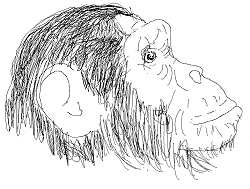 Hugh Howey gives a bold, amusing, and hopelessly optimistic account of how to construct consciousness in Wired. He thinks it wouldn’t be particularly difficult. Now you might think that a man who knows how to create artificial consciousness shouldn’t be writing articles; he should be building the robot mind. Surely that would make his case more powerfully than any amount of prose? But Howey thinks an artificial consciousness would be disastrous. He thinks even the natural kind is an unfortunate burden, something we have to put up with because evolution has yet to find a way of getting the benefits of certain strategies without the downsides. But he doesn’t believe that conscious AI would take over the world, or threaten human survival, so I would still have thought one demonstration piece was worth the effort? Consciousness sucks, but here’s an example just to prove the point?
Hugh Howey gives a bold, amusing, and hopelessly optimistic account of how to construct consciousness in Wired. He thinks it wouldn’t be particularly difficult. Now you might think that a man who knows how to create artificial consciousness shouldn’t be writing articles; he should be building the robot mind. Surely that would make his case more powerfully than any amount of prose? But Howey thinks an artificial consciousness would be disastrous. He thinks even the natural kind is an unfortunate burden, something we have to put up with because evolution has yet to find a way of getting the benefits of certain strategies without the downsides. But he doesn’t believe that conscious AI would take over the world, or threaten human survival, so I would still have thought one demonstration piece was worth the effort? Consciousness sucks, but here’s an example just to prove the point?
What is the theory underlying Howey’s confidence? He rests his ideas on Theory of Mind (which he thinks is little discussed); the ability to infer the thoughts and intentions of others. In essence, he thinks that was a really useful capacity for us to acquire, helping us compete in the cut-throat world of human society; but when we turn it on ourselves it disastrously generates wrong results, in particular about our own having of conscious states.
It remains a bit mysterious to me why he thinks a capacity that is so useful applied to others should be so disastrously and comprehensively wrong when applied to ourselves. He mentions priming studies, where our behaviour is actually determined by factors we’re unaware of; priming’s reputation has suffered rather badly recently in the crisis of non-reproducibility, but I wouldn’t have thought even ardent fans of priming would claim our mental content is entirely dictated by priming effects.
Although Dennett doesn’t get a mention, Howey’s ideas seem very Denettian, and I think they suffer from similar difficulties. So our Theory of Mind leads us to attribute conscious thoughts and intentions to others; but what are we attributing to them? The theory tells us that neither we nor they actually have these conscious contents; all any of us has is self-attributions of conscious contents. So what, we’re attributing to them some self-attributions of self-attributions of… The theory covertly assumes we already have and understand the very conscious states it is meant to analyse away. Dennett, of course, has some further things to say about this, and he’s not as negative about self-attributions as Howie.
But you know, it’s all pretty implausible intuitively. Suppose I take a mouthful of soft-boiled egg which tastes bad, and I spit it out. According to Howey what went on there is that I noticed myself spitting out the egg and thought to myself: hm, I infer from this behaviour that it’s very probable I just experienced a bad taste, or maybe the egg was too hot, can’t quite tell for sure.
The thing is, there are real conscious states irrespective of my own beliefs about them (which indeed, may be plagued by error). They are characterised by having content and intentionality, but these are things Howie does not believe in, or rather it seems has never thought of; his view that a big bank of indicator lights shows a language capacity suggests he hasn’t gone into this business of meaning and language quite deeply enough.
If he had to build an artificial consciousness, he might set up a community of self-driving cars, let one make inferences about the motives of the others and then apply that capacity to itself. But it would be a stupid thing to do because it would get it wrong all the time; in fact at this point Howie seems to be tending towards a view that all Theory of Mind is fatally error-prone. It would better, he reckons, if all the cars could have access to all of each other’s internal data, just as universal telepathy would be better for us (though in the human case it would be undermined by mind-masking freeloaders.
Would it, though? If the cars really had intentions, their future behaviour would not be readily deducible simply from reading off all the measurements. You really do have to construct some kind of intentional extrapolation, which is what the Dennettian intentional stance is supposed to do.
I worry just slightly that some of the things Howey says seem to veer close to saying, hey a lot of these systems are sort of aware already; which seems unhelpful. Generally, it’s a vigorous and entertaining exposition, even if, in my view, on the wrong track.

